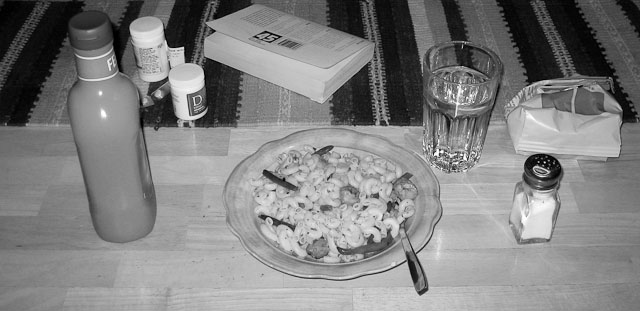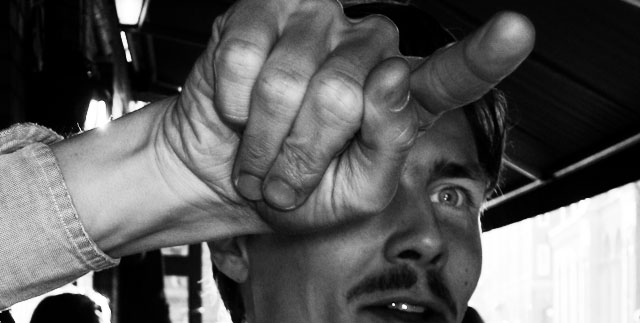Perhaps I ought to learn at least some phrases in Finnish. I feel as close to an imperialist as I’ve ever have, asking people “svenska, talar du svenska?” all the time. Case in point: I forgot to bring a carry-around bag so went hunting for one in second hand stores. In one cramped store I find a cloth bag but try to ask the older lady if she possibly has something similar but with longer handles, appropriate for fashionable slinging up on ones shoulder. I go through English and Swedish and pantomime and am bringing out my notebook for some Pictionary, when both she and her co-worker just wave me out of the store, with a “thank you” (unless “kippis” has a second meaning, such as “shove off”) and gesturing that I can take the bag and leave. At least I hope that’s what they meant, but for all I know they thought I was telling them to “put all your money in this bag, make it large money,” and they were thanking me for not hurting them. I don’t know.
I had ambitions when I first got here that I’d use the time to whip my pasty butt into some sort of shape resembling an actual butt, and started out strong with jogging every second day and even going so far as to checking out the dorm gym. A week later I’m feeling a slight cold coming on and I’m drinking beer and eating crisps for dinner. I’m sure there is a middle-ground somewhere, but I’d be fucked if I can find it. I do hope that I’ll keep up the running though, if for no other reason than to balance out the hours sitting in the studio poking at the RepRap.
Speaking of which, I’m having some progress in the building department, and have half of it put together already. It’s probably the most straightforward part of this whole endeavor, and mostly entails following instructions and spinning a lot of bolts onto rods and such, but at least there’s a physical thing I can point to and say: Behold! Yesterday twas but a heap of rods, today it stands on it’s extruded feet. Verily, progress! etc. etc.
[x_video_embed no_container=”true”][/x_video_embed]
Two more observations regarding the traffic in Turku: First off, the bikers here drive poorly, often on sidewalks or against the flow of other bikes, while at the same time not signaling. This is in large part because the bike lanes are merged with sidewalks more often than motor traffic, and it’s just too crowded with pedestrians to allow smooth going.
Secondly, drivers are much less likely to stop for you at a zebra crossing, even if you’re already halfway in the road. Anecdotal data, and so on, but it’s happened enough times for me to notice. Also, people are very hesitant to walk on red on a crossing, even when it’s safe; It’s possible they know something I don’t. My lack of inhibition in this area makes me feel very low level badass, as pedestrian badassery goes.
Maybe related: back home people get the hell out of the way when there’s an emergency vehicle flashing lights, while on three occasions I’ve seen an ambulance or cop car stuck behind traffic which didn’t budge. Granted, once it was an older driver obviously lost and looking for the right exit, but you’d imagine that the honking, blinking, waving and shouting police behind her was a clear enough signal. So perhaps it’s an indication of an individualistic yet wary mindset? Should one do generalizations of a whole city — nay people — on the basis of walking back and forth along four streets for a week? Of course one should, what kind of question is that?







